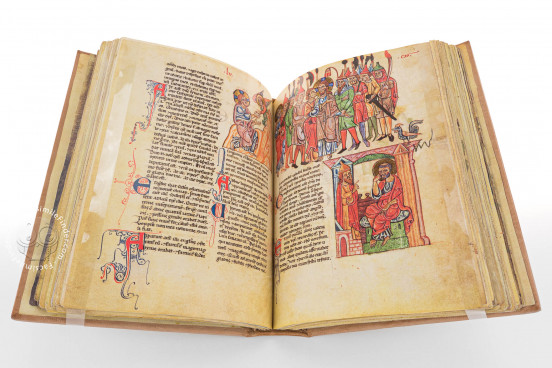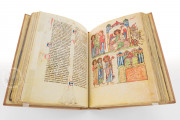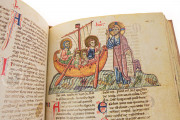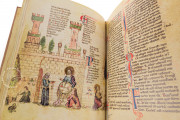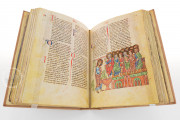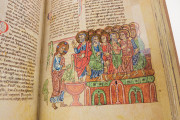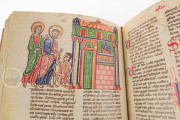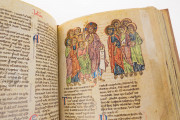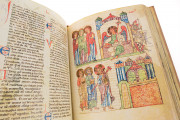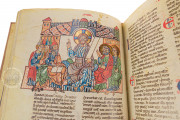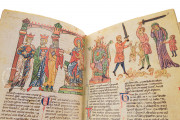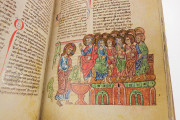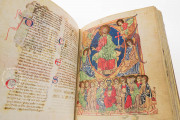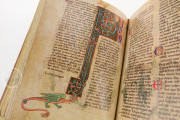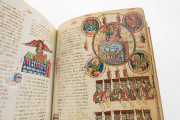The Verona New Testament is remarkable for being a Christian biblical New Testament manuscript intended for use in private study. It was made in Verona in the second quarter of the thirteenth century and boasts a dazzling array of nearly 200 narrative miniatures and marginal vignettes illustrating the Gospel accounts of the life of Christ, the Acts of the Apostles, and the Apocalypse—including scenes rarely found in the art of the period.
The manuscript was carefully planned for its illumination, which varies in intensity and form among the biblical books. The Gospels and Acts are dominated by half-page and column miniatures, whereas the Epistles are almost exclusively embellished with painted initials. The illustrations in the Apocalypse—the most copiously illustrated section of the book—are mostly marginal vignettes.
Lively Narratives
Several artists executed the manuscript's illumination in a style scholars characterize as "Italo-Byzantine cloisonné" for the clear influence of the appearance of Byzantine enamels. The miniatures, whether large or small, are mostly unframed, with the unpainted parchment serving as a ground. They are alive with engaging details, such as the dogs nipping at the heels of the poor man in the image of the Parable of Lazarus and Dives (fol. 56v).
Unusual Subjects
There was little tradition in Western Europe for illustrating the events described in the Acts of the Apostles. Among the remarkable inclusions in the Verona New Testament are the miniatures of Saint Philip explaining a passage of Isaiah to an Ethiopian eunuch (fol. 91r) and Saint Peter's vision of a great linen sheet showing "four-footed beasts, creeping things of the earth, and fowls of the air" (fol. 93r).
A Book to Be Studied Throughout the Year
The manuscript was presumably created for the layman—not an aristocrat—kneeling in prayer before the enthroned Virgin and Child at the end of the book (fol. 172r). He was probably the member of one of Verona's penitential confraternities. His study of the New Testament and his devotions were probably performed in an anuual cycle embodied in the book's liturgical calendar (fols. 1-3).
Carefully Planned Mise-en-Page
At least two scribes wrote the manuscript's original text, and a number of additions were made, probably in the fourteenth century. It was mostly written in two columns but adjusted to a single column for much of the Apocalypse to accommodate the abundance of illustration in that section (fols. 158v-166r and 168v-170r).
The script is early Gothic Textualis. The text was carefully corrected, and one passage that was originally missing was supplied in the margin with a painted embellishment that includes a bird (fol. 80r).
An Early Owner
One Giovanni Georgii, son of Bartholomeus, owned the book within a century of its creation. Like the original owner, he may well have been a member of a lay Christian confraternity. The manuscript entered the Vatican library in the fifteenth century.
We have 1 facsimile edition of the manuscript "Verona New Testament": Neues Testament facsimile edition, published by Belser Verlag, 1984
Request Info / Price
